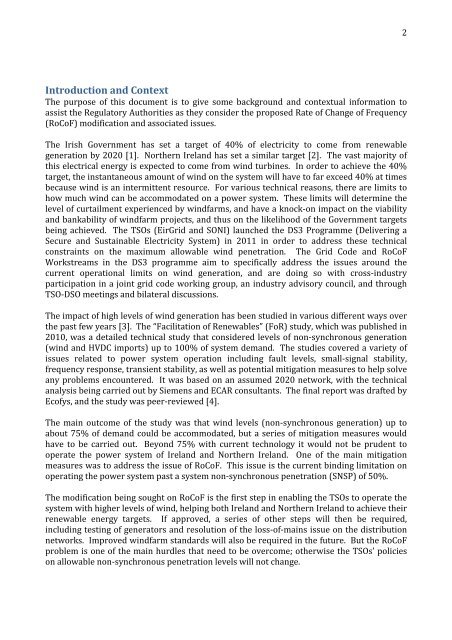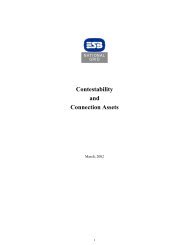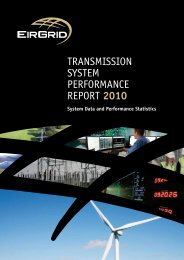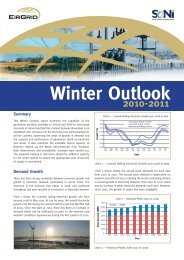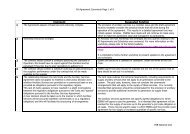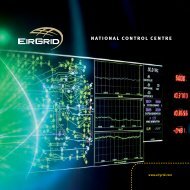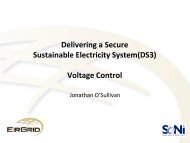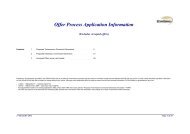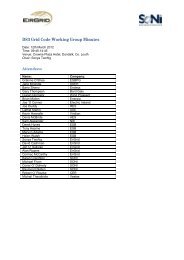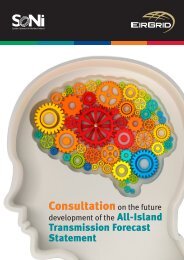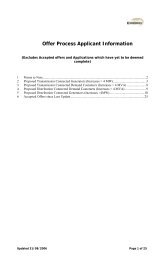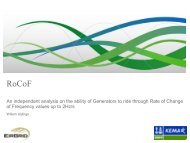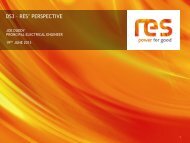RoCoF Modification Proposalâ TSOs' Recommendations - Eirgrid
RoCoF Modification Proposalâ TSOs' Recommendations - Eirgrid
RoCoF Modification Proposalâ TSOs' Recommendations - Eirgrid
Create successful ePaper yourself
Turn your PDF publications into a flip-book with our unique Google optimized e-Paper software.
2Introduction and ContextThe purpose of this document is to give some background and contextual information toassist the Regulatory Authorities as they consider the proposed Rate of Change of Frequency(<strong>RoCoF</strong>) modification and associated issues.The Irish Government has set a target of 40% of electricity to come from renewablegeneration by 2020 [1]. Northern Ireland has set a similar target [2]. The vast majority ofthis electrical energy is expected to come from wind turbines. In order to achieve the 40%target, the instantaneous amount of wind on the system will have to far exceed 40% at timesbecause wind is an intermittent resource. For various technical reasons, there are limits tohow much wind can be accommodated on a power system. These limits will determine thelevel of curtailment experienced by windfarms, and have a knock-on impact on the viabilityand bankability of windfarm projects, and thus on the likelihood of the Government targetsbeing achieved. The TSOs (EirGrid and SONI) launched the DS3 Programme (Delivering aSecure and Sustainable Electricity System) in 2011 in order to address these technicalconstraints on the maximum allowable wind penetration. The Grid Code and <strong>RoCoF</strong>Workstreams in the DS3 programme aim to specifically address the issues around thecurrent operational limits on wind generation, and are doing so with cross-industryparticipation in a joint grid code working group, an industry advisory council, and throughTSO-DSO meetings and bilateral discussions.The impact of high levels of wind generation has been studied in various different ways overthe past few years [3]. The “Facilitation of Renewables” (FoR) study, which was published in2010, was a detailed technical study that considered levels of non-synchronous generation(wind and HVDC imports) up to 100% of system demand. The studies covered a variety ofissues related to power system operation including fault levels, small-signal stability,frequency response, transient stability, as well as potential mitigation measures to help solveany problems encountered. It was based on an assumed 2020 network, with the technicalanalysis being carried out by Siemens and ECAR consultants. The final report was drafted byEcofys, and the study was peer-reviewed [4].The main outcome of the study was that wind levels (non-synchronous generation) up toabout 75% of demand could be accommodated, but a series of mitigation measures wouldhave to be carried out. Beyond 75% with current technology it would not be prudent tooperate the power system of Ireland and Northern Ireland. One of the main mitigationmeasures was to address the issue of <strong>RoCoF</strong>. This issue is the current binding limitation onoperating the power system past a system non-synchronous penetration (SNSP) of 50%.The modification being sought on <strong>RoCoF</strong> is the first step in enabling the TSOs to operate thesystem with higher levels of wind, helping both Ireland and Northern Ireland to achieve theirrenewable energy targets. If approved, a series of other steps will then be required,including testing of generators and resolution of the loss-of-mains issue on the distributionnetworks. Improved windfarm standards will also be required in the future. But the <strong>RoCoF</strong>problem is one of the main hurdles that need to be overcome; otherwise the TSOs’ policieson allowable non-synchronous penetration levels will not change.


